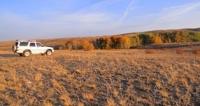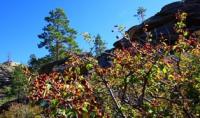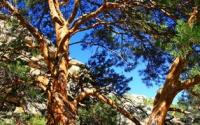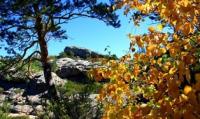You are here
Researches nature of Aiyrtau.





Sights of Aiyrtau mountains in Kokshetau.
“On a smooth, barely fluctuating surface, there were thousands of different species, birds and birds the size and size, swimming, sinking, looking in the mirror of its waters, it seemed, every genus of birds that day was beautiful on this beautiful summer time, thinking about one enjoyment, forgot to continue his being. Will I be allowed a bold, but it seems fair remark that birds, to please nature, know the science of using life better than all its creations? For them, the time of year has no drawbacks: leaving a boring autumn and a harsh winter in one country, they fly to another to enjoy the pleasantness of spring and the warmth of summer”
Diary of Ivan Shangin. Publication by the 8th grade bergmeister by publisher G.I. Spassky. "Herald of Europe" in 1816.
Excursions in mountains Aiyrtau on Imantau Lake.
Information about the nature of certain territories in the south of Western Siberia is found in the Mongolian chronicle and in some eastern authors as early as the XIIIth century. This is our territory now. Special geographical studies of the territory on which the Aiyrtau district is located began in the XIXth century.
Geographically, our area by the XIX century was little studied, although the mineral and other wealth of the region attracted the attention of Russians already under Catherine II. But the restless nomadic population, the lack of convenient communication lines and natural obstacles prevented a quick acquaintance with the region.
Many scientists, travelers and researchers took part in the study of the region, let us briefly dwell on the contribution of some of them. In the spring of 1816, by order of the Governor General of Western Siberia, a military research expedition was equipped in the Kokchetav district.
The expedition was led by a mountain officer, mine surveyor Ivan Petrovich Shangin. In the words of I. Shangin, the purpose of the expedition was “to examine the ore mines discovered there, measure the paths that led to them, and study the works of the three kingdoms of nature - these are rocks, flora and fauna.”
The expedition consisted of 200 people: mountain officials, craftsmen, translators, guides, paramedics, officers and Cossacks. The expedition of I. Shangin in the territory of our region explored the mountains of Imantau, Aiyrtau, Zhaksyzhalgiztau.
Lakes Saumalkol, Shalkar, Lobanovskoye, Baysary, Imantau, Zhaksyzhalgiztau, the rivers Imanburlyk and Babykburlyk were included in the field of study of the expedition. The expedition was interested in the vegetative landscapes of the area and settlements encountered along the route.
On May 20, 1816, Shangin's detachment moved west along granite hills to Mount Imantau. At the foot of Mount Imantau, on the edge of a pine forest, “miraculous mines” were discovered. In Shangin’s descriptions one can find information about Lake Logov “on a smooth, barely swollen surface of the lake (meaning the lake), thousands of different species, colors and sizes of birds swam, plunging, looked in the mirror of his waters, it seemed, every one of them feathered on this day during the wonderful summer time I was thinking about one pleasure.”
Porphyritic, overgrown with birch and shrubs, Mount Zhaksyzhalgyztau and the lake at its foot, lead I.P. Shangina to the delight. This is what the fish wealth of Lake Zhaksyzhalgiztau looks like in Shangin’s descriptions “Pikes, ides, tench, perches with chebaks are very tasty and extremely large breed in plenty in the healthy water of this lake”.
Ivan Shangin was also interested in the toponymy of the names of our region: “What decent names Kyrgyz give their rivers, lakes, mountains, meadows and plains, it is amazing. Mount Yakshi-Zhangyz-Tau (translated as “one of the best mountains”) is truly beautiful.”
A more complete description of the territory of the Ayyrtau region can be found in the work of I.Ya. Slovtsova "Travel notes, conducted during a trip to the Kokchetav district of Akmola region in 1878." The route of I. Slovtsov’s expedition ran “from Dzhemantau to Lake Saumal-kul” further to the mountains of Aiyrtau, further to the Imantau mountains and to Mount Zhaksyzhalgiztau.
The expedition of I. Slovtsov can be called complex, since all the components of the nature of the region, as well as the population and its economic activity, were studied. When studying the territory of our region, Slovtsov also noted environmental problems.
The Soviet period in the history of geographical studies of the Ayyrtau region should be associated with the study of mineral resources from the 40s to the 90s. As a result of such studies, large discovered deposits of uranium, tin, tungsten and other minerals.
Authority:
http://op-airtau.sko.kz
Photo
Alexander Petrov.







